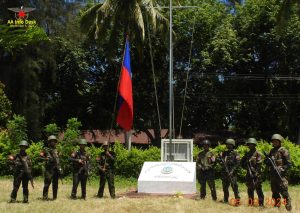In Myanmar’s complex landscape, which includes scores of ethnic armed organizations (EAOs) and People’s Defense Forces, the Arakan Army (AA) stands out as the one group with a real chance of achieving its goal of autonomy – or even independent nationhood. There are two key reasons why Rakhine State, also known as Arakan, might emerge as Myanmar’s first fully autonomous region, free from both the Myanmar military and foreign interference. The first factor is the unique leadership and unity among the Rakhine people themselves; the second is the state’s geopolitically significant location, which makes it resistant to direct foreign control.
The AA was formed in 2009 by Twan Mrat Naing and 25 young Rakhine nationalists in Kachin State. In just over a decade, the group has grown into one of Myanmar’s most formidable forces. Twan Mrat Naing’s leadership, along with that of Brig. Gen. Nyo Twan Awng, has been instrumental in creating a strong military organization with a clear vision of reviving the “Arakan Nation” through what they call the “Arakan Way.”
As of 2022, the AA claimed to have trained over 30,000 soldiers, with some estimates suggesting that the group could field up to 40,000 combatants. What sets the AA apart from other EAOs is its leaders’ ability to rally a unified movement. Arakan’s historical struggle for independence, dating back to the fall of the Mrauk-U Kingdom to a Burmese invasion in 1784, has seen numerous attempts to break free from Burmese and British control. However, unlike their predecessors, Twan Mrat Naing and his colleagues have successfully incorporated older generations of Arakanese nationalists into their movement, enabling them to build a broad-based, intergenerational leadership that is committed to a long-term vision.
A major reason for the AA’s rapid rise is its pragmatic leadership, which has successfully blended short-term goals with longer-term aspirations, encapsulated in slogans like the “Arakan Dream 2020” and the “Way of Rakhita.” Their ability to provide a clear roadmap has galvanized followers who know exactly what their leaders aim to achieve. The AA’s strong organizational capacity, combined with its ability to effectively communicate its vision, has helped it emerge as a credible force capable of negotiating with or resisting the Myanmar military.
The second factor in the AA’s potential for autonomy is its geopolitical positioning. Unlike other EAOs, the AA is not heavily influenced by or reliant on foreign powers. Many ethnic armed groups in Myanmar’s north, such as its allies, the Ta’ang National Liberation Army (TNLA) and the Myanmar National Democratic Alliance Army (MNDAA), operate under significant Chinese influence. These groups are often forced to limit their actions based on China’s geopolitical interests. For instance, during Operation 1027, a significant offensive against the Myanmar military in northern Shan State, the TNLA and MNDAA, which along with the AA form the Three Brotherhood Alliance, have had to halt their operations on a number of occasions due to pressure from China. Even the United Wa State Army (UWSA) – widely regarded as Myanmar’s largest non-state armed group and a clandestine supplier of weapons to various factions, including the Three Brotherhood Alliance – operates within the confines of China’s strategic interests.
In contrast, the AA operates with relative freedom from Chinese interference, especially within Rakhine State, a condition that the UWSA might even envy. While the AA cooperates with its allies, it maintains autonomy in its decision-making when it comes to Rakhine affairs. In a recent interview, Twan Mrat Naing pointed out that China is simply pursuing its own national interests, and that the AA is doing the same. This independence allows the AA to craft its own strategy for Rakhine without being beholden as much to external powers.
While China has interests in Rakhine, particularly through its Belt and Road Initiative, India’s geopolitical stakes in the region may be more significant. The Kyaukphyu Deep Sea Port, part of the China-Myanmar Economic Corridor, provides China with direct access to the Indian Ocean, bypassing the Malacca Strait. India’s concern is that if China controls this strategic seaport, it could pose a serious disadvantage to India in the region.
Rakhine also plays a crucial role in India’s Kaladan Multi-Modal Transit Transport Project, which aims to connect northeastern India with the rest of the country via the Bay of Bengal, through Rakhine’s capital and seaport of Sittwe. Mainland India is connected to its northeastern states, also known as the “Seven Sisters of India,” only by a narrow stretch of land in West Bengal called the Chicken’s Neck (or Siliguri Corridor). Once that narrow passage is blockaded, New Delhi will lose direct overland connection with a huge chunk of its territory, a connection that is already weak to begin with.
Therefore, for India, losing access to Rakhine State’s coastline would be a major setback, making it unlikely that New Delhi would allow China or any other power to dominate the region. This geopolitical dynamic provides the AA with leverage, as both China and India have vested interests in ensuring good relations with whoever controls Rakhine.
Given these factors, Rakhine State is well-positioned to become Myanmar’s first truly autonomous region. The strong leadership of the AA, coupled with its ability to navigate the region’s complex geopolitical landscape, sets it apart from other ethnic groups in Myanmar. While the road to autonomy is fraught with challenges, the AA’s unique ability to resist both Myanmar military control and foreign influence gives it a real shot at carving out a new future for Rakhine.
The world should watch closely as Rakhine’s quest for autonomy unfolds. It could reshape not just Myanmar, but also the broader geopolitical dynamics of Southeast Asia.

































